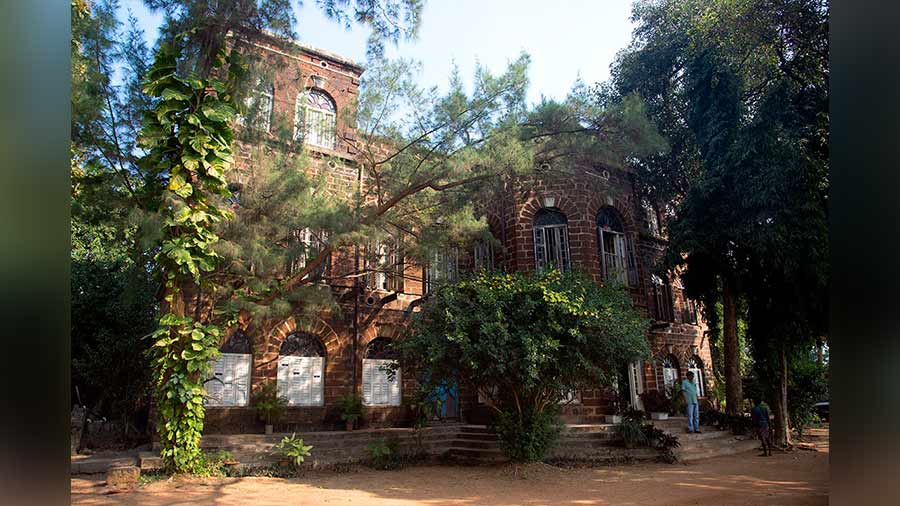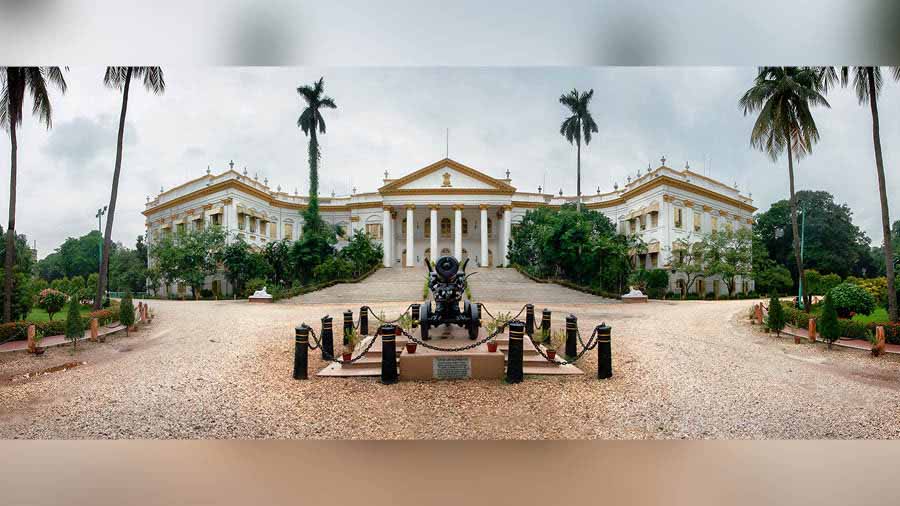A huge Chakunda tree formed a canopied entrance to the dark red laterite stone house — looking like a medieval European castle with a lofty gate and turrets in each corner — magically perched in the middle of these bucolic settings of rural Odisha. As we disembarked from our car, we were immediately greeted by the happy barks of two dogs, and an observant cat. A tall, lanky gentleman strode towards us with an affable smile on his face. He introduced himself as Debjit Singh Deo. His great grandfather, Raja Jyoti Prasad Singh Deo of Panchkote, had built this two-storeyed mansion in 1933 as a royal hunting lodge.
“Restoring the palace to its erstwhile glory was indeed a challenge for us,” said Debjit, as we settled in the cavernous sitting room, sipping tea and munching some crispy fritters that had just arrived from the kitchen. After serving as the hunting lodge for the royal family for a few decades, it lay abandoned for years. That’s when Debjit and his wife, Namrata Kumari, who also has a royal lineage from the princely state of Nagod in Madhya Pradesh, decided to move into this house. The enterprising couple painstakingly restored it, carefully retaining the authenticity and regal charm with period furniture and many of the original props, before opening a few of the rooms for intrepid guests travelling to this part of Odisha.
A brief history of the royal lodge
Debjit told us the history of this ancestral house. Jyoti Prasad Singh Deo was on a hunting expedition with a royal entourage of Panchkote, replete with carts, elephants and porters. When he reached the borders of the princely state of Bamra, he sent an emissary to the boy king of Bamra, to seek a hunting permission in his territory. Now, the rulers of Panchkote were not in the good books of the British colonists due to their continued opposition, quite a rarity among the kings and zamindars in those days. The British resident, in charge of the minor king of Bamra, did not let go of an opportunity to take a swipe. Jyoti Prasad was denied an entry into Bamra’s forest.
Embarrassed and humiliated, Jyoti Prasad came back home and proceeded to buy 11,000 acres of forest land in the nearby province of Choudwar, and retained sole hunting rights in his newly-acquired estate. He went on to build a two-storeyed mansion, where he would base himself to organise many a hunting expedition.
An exciting forest trail
Early next morning, Debjit led us through a trail in the forest around Kila Dalijoda. The jungle is a part of the famed Kapilash Elephant Sanctuary and pachyderms often veer close to the mansion, Debjit said. We did not spot any elephant though, but the lush green stretch turned out to be an ornithologist’s delight with its pack of parakeets, jungle fowls, black-headed orioles and Indian roller birds. A kingfisher dazzled us with its mélange of hues as it flew from an Arjuna tree to a solitary pole on a small water body. “It’s their nesting time,” Debjit informed. A keen naturalist, Debjit has been organising immersive tours for school children in these forests and also in nearby Bhitarkanika National Park for a better understanding of forest management and conservation of wildlife and biodiversity.
Tribal hamlet of Shabar community

A tribal village near Kila Dalijoda
Soon, we reached a tribal hamlet of Shabar community. A hunter-gatherer tribe, the Shabars are some of the earliest inhabitants of the plateaus and plains of eastern India, and it was wonderful to have an intimate glimpse into their quiet, unhurried flow of life, as we wandered through the cluster of humble mud-and-straw homesteads. It was heartening to note that the village is free from the overarching urban trend of “tribal tourism” that often disrupts the natural rhythm of indigenous lifestyle, with minimal benefits to them. “We don’t want to project our villages as showpieces and let our guests interact with the residents of these hamlets as acquaintances, not intruders,” said Debjit, as we took our leave from a middle-aged Shabar lady, who was enlightening us with ways of making rice-beer and its health benefits.
On our return to the mansion, we found our hostess Namrata ready with a sumptuous lunch — a delectable mix of Odishi cuisine and old favourites from the Panchkote royal kitchen. With dainty pancakes encased in turmeric leaves as starters, a tangy and spicy mutton dish served with soft pies for mains and the proverbial Odishi chhena poda as dessert, it was a delicious and exotic treat for the famished souls after a hard morning’s work.
Halt at Odisha State Maritime Museum in Cuttack
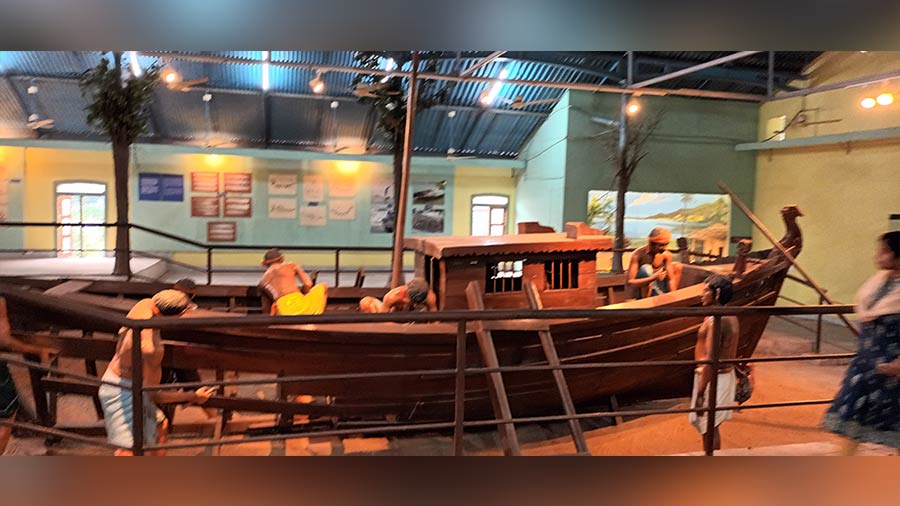
A model of a boat inside Odisha State Maritime Museum
Our post-lunch session was reserved for two very well-maintained museums in Cuttack. Odisha State Maritime Museum chronicles ancient Odisha’s fabled maritime trade through exquisite exhibits from the early medieval period to the colonial era. The museum stands on the site of the Maritime Engineering Workshop established by the British on the banks of River Mahanadi and has meticulously recreated the workshop through life-sized sculptures, machines and naval apparatus that were used back in those days.
Netaji’s ancestral house in Cuttack, a must see
Next, we stopped at Netaji’s ancestral house in Cuttack – a rambling mansion where the legendary hero was born and spent his early years. Now converted into a museum, the rooms are chock-a-block with Netaji memorabilia, family furniture and personal artefacts.
Weavers’ hamlet of Nuapatna
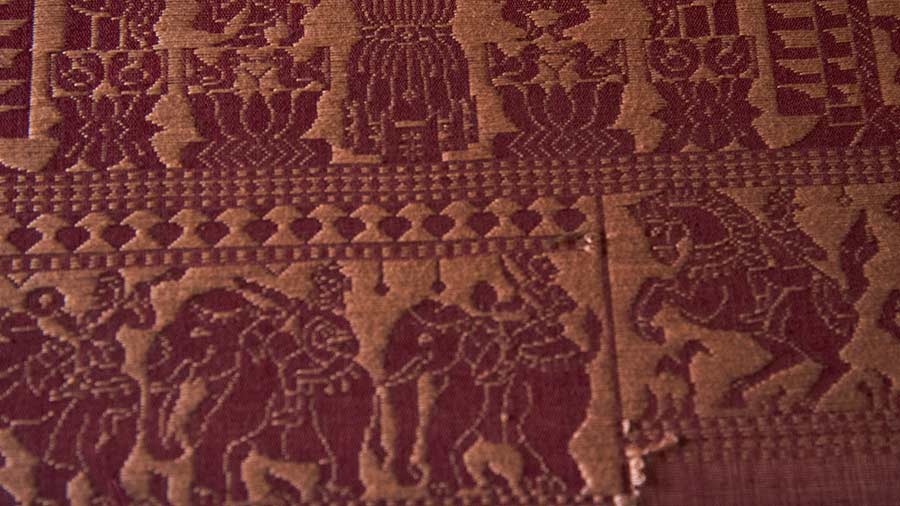
Don't miss the details in the weaving at Nuapatna village
The next day’s excursion was to the craft villages near Kila Dalijoda. After a 60km drive through leafy countryside, we rolled into the weavers’ hamlet of Nuapatna, where the traditional craft of handloom weaving dates back centuries ago. The village street was entangled with lengths of colourful warp thread tied between poles, wefts stretched on frames and a whirring buzz of spinning wheels emitted from the humble homesteads. Debjit took us to the workshop of Sarat Kumar Patra, a master weaver in the trade for more than 50 years. A multi-award winner artisan, including national award for weaving the portrait of ‘Dasha Avatar’ in 1993, Patra demonstrated the painstaking process of Ikat weaving – from the painted designs, their translations on to graph papers and finally the evolution into meticulous patterns woven into textiles around spiritual, religious and aesthetic motifs.
Sadeibareni village of dokra art in Dhenkanal
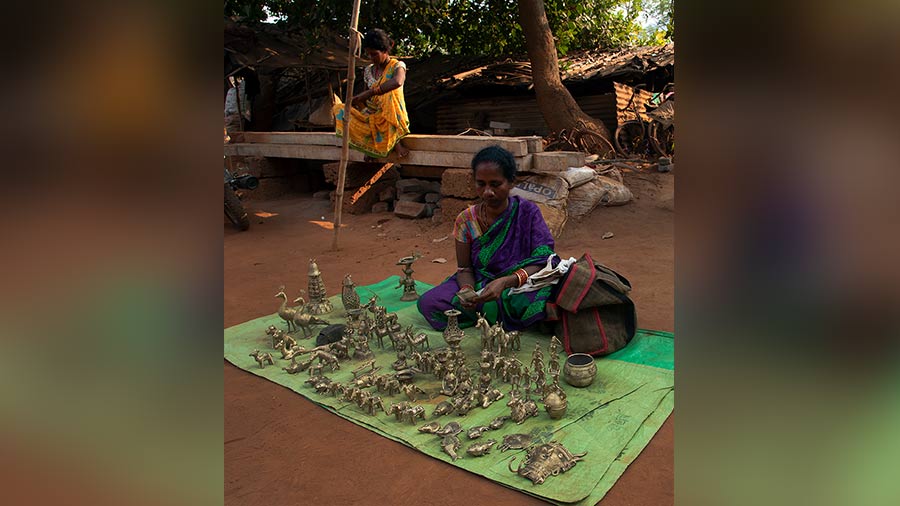
A tribal lady with her dokra craft at Sadeibareni village
Our next pit stop was Sadeibareni – a tribal village in Dhenkanal district, home to about 50 families with 140-odd artisans who have solidly placed this remote hamlet into the world map with their ancient Dokra or bell metal craft that dates back to the period of Indus Valley Civilisation. We were shown the intricacies of this metal casting art that uses brass and bees-wax and brings out wispy mesh-like threads that lends a distinctive beauty to the dainty ensemble of tribal figurines, animal sculptures, deities and sundry decorative pieces such as vases, door handles and photo-frames.
Headquarters of Alekh Mahima Dharma

Sadhus praying at the monastery
The trip finale would be a surprise, Debjit had promised us. It was late afternoon when we arrived in Joranda at the rainbow-coloured gate of the headquarters of Alekh Mahima Dharma, a religious order that worships an omnipresent, formless god and shuns conventional strictures, including the caste system. This little-known Hindu cult dates back to the latter half of the 19th century. The monks lead a simple life of asceticism, celibacy and meditation. Evening prayers had started when we reached the monastery. Clad in saffron loin-clothes, a motley squadron of dreadlocked sadhus held up their bare hands and chanted in unison “Alekh Mahima” repeatedly, as we, along with a band of fascinated spectators, watched in silence.
Dusk descended gently on the vast monastic complex, where the idol-less temples were now being lit with lamps. In the gathering darkness we turned back towards Kila Dalijoda, our home away from home for these three days with its beautiful stained-glass windows, royal bedchambers and a dark red façade that reminds one of a European castle.
— Sugato Mukherjee is a Kolkata-based photographer and writer whose work has appeared in The Globe and Mail, Al Jazeera and Nat Geo Traveller, among other places. He is the author of a coffee-table book on Ladakh and a book on the sulphur miners of East Java.
